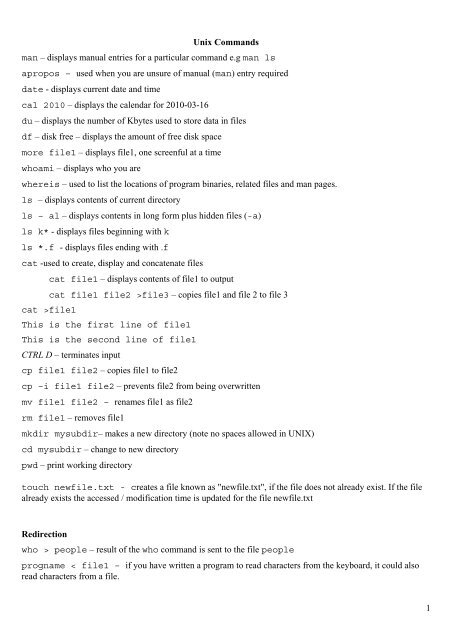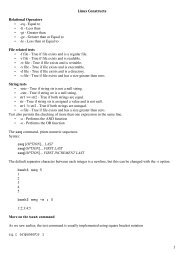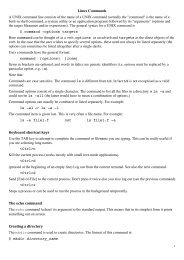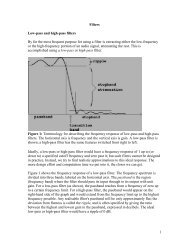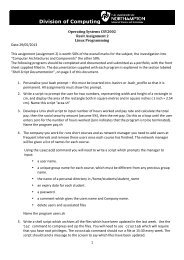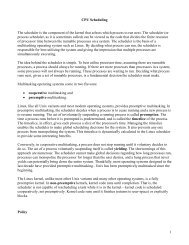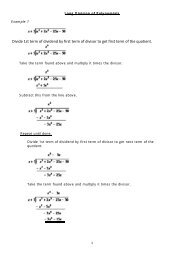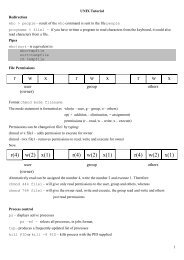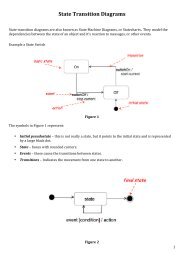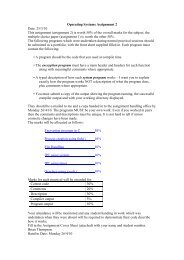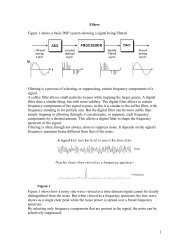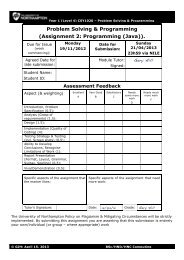You also want an ePaper? Increase the reach of your titles
YUMPU automatically turns print PDFs into web optimized ePapers that Google loves.
<strong>Unix</strong> <strong>Commands</strong>man – displays manual entries for a particular command e.g man lsapropos – used when you are unsure of manual (man) entry requireddate - displays current date and timecal 2010 – displays the calendar for 2010-03-16du – displays the number of Kbytes used to store data in filesdf – disk free – displays the amount of free disk spacemore file1 – displays file1, one screenful at a timewhoami – displays who you arewhereis – used to list the locations of program binaries, related files and man pages.ls – displays contents of current directoryls – al – displays contents in long form plus hidden files (-a)ls k* - displays files beginning with kls *.f - displays files ending with .fcat -used to create, display and concatenate filescat file1 – displays contents of file1 to outputcat file1 file2 >file3 – copies file1 and file 2 to file 3cat >file1This is the first line of file1This is the second line of file1CTRL D – terminates inputcp file1 file2 – copies file1 to file2cp –i file1 file2 – prevents file2 from being overwrittenmv file1 file2 – renames file1 as file2rm file1 – removes file1mkdir mysubdir– makes a new directory (note no spaces allowed in UNIX)cd mysubdir – change to new directorypwd – print working directorytouch newfile.txt - creates a file known as "newfile.txt", if the file does not already exist. If the filealready exists the accessed / modification time is updated for the file newfile.txtRedirectionwho > people – result of the who command is sent to the file peopleprogname < file1 – if you have written a program to read characters from the keyboard, it could alsoread characters from a file.1
Pipeswho|sort - is equivalent to:who>tmpfilesort
Access. You can use ping to see if you can reach another computer.Time & distance. You can use the ping command to determine how long it takes to bounce a packetoff of another site, which tells you its Internet distance in network terms.Domain IP address. You can use the ping command to probe either a domain name or an IP address. Ifyou ping a domain name, it helpfully displays the corresponding IP address in the response.ArithmeticTry the following$ expr 2 + 1$ expr 7 – 2$ expr 4 * 5The last one produces an error message as the multiplication operator needs to be quoted (preceded by a \ ) toprotect it from shell expansion. This is because the * is a metacharacter, which have a special meaning to theshell, such as < > * ? | &.$ expr 8 / 5$ expr 19 % 5$ expr 6 + 7 \* 4$ expr `expr 6 + 7` \* 4Variables$ FIRST=John$ echo $FIRSTThis creates a variable named FIRST, sets it’s value to John. To read the value of the variable you must precedeit’s name with a $ symbol.To remove a variable use the unset command as in:$ echo $FIRSTJohn$ unset FIRST$ echo $FIRST$Shell Scriptsecho $SHELL – echoes which shell we are runningCreate a file (first.sh) as follows:#!/bin/bash# This is a comment!echo Hello World3
The first line tells <strong>Unix</strong> that the file is to be executed by the /bin/bash shell.$ chmod 755 first.sh$ ./first.shHello World$Now a second script#!/bin/bas#This script displays the date, time, username and current directoryecho date and time is :dateechoecho your username is : `whoami`echo your current directory is:pwdNotice the back quotes (` `) are used for command substitution in a line commencing echo. The back quote isstill often used for command substitution, although the $() combination (a dollar sign and brackets) is generallypreferred.Creating a personal bin directoryAll executable files must be executed in a bin directory and the path to that directory included in your.bash_profile file.To create a bin directory in your area type:$ mkdir binensuring it is where you want it and you know the absolute pathname.You will probably need to type:$ ls – alto see hidden files which are preceded by a dot.Save a copy of your .bash_profile file to another file. E.g.$ cp .bash_profile bash_profile_copyThen using vi or similar open the .bash_profile file which should be in your area.Then add the following line to the end of the file:PATH=${PATH}:absolute-pathname-to-binexport PATHYou will need to re-boot Linux to re-run the .bash_profile otherwise the PATH won’t be recognised.4
Simple constructsTry the following:1.#!/bin/bash# this program counts from 1 to 10:for i in 1 2 3 4 5 6 7 8 9 10; doecho $idone2.3.#!bin/bashfor i in `seq 1 10`; doecho item: $idone#!bin/bashfor i in $( ls); doecho item: $idoneThe test commandTry the following$ test 3 -gt 4 && echo True || echo falsefalse$ [ "abc" != "def" ];echo $?0Where echo $? returns the exit status of the command. Zero means the command executed successfully, if exitstatus returns non-zero value then your command failed to execute.In the first example the -gt operator performs an arithmetic comparison between two literal values. In thesecond example, the alternate [ ] form compares two strings for inequality. Notice that the spaces after theopening bracket and before the closing bracket are a MUST.You can compare arithmetic values using one of -eq, -ne, -lt, -le, -gt, or -ge, meaning equal, not equal,less than, less than or equal, greater than, and greater than or equal, respectively.Examples1.#!bin/bashread xwhile [ “$x” ]doprintf “%20s\n” $xread x2.done#!bin/basht1=”bog”t2=”off”5
if [ “$t1“ = “$t2“ ]; thenecho expression evaluated as trueelseecho expression evaluated as falsefi3. Then change T2 to bog and see if it evaluates correctly4.#!bin/bashecho Enter aread aecho Enter bread becho Enter cread ctotal=$(expr `expr $a + $b + $c` / 3)echo The mean is $totalecho $aecho $becho $cif ([ $c –gt $b ] && [ $a –lt $b ]);thenecho b = $b and is the medianelif ([ $a –gt $c ] && [ $b –lt $c ]);thenecho c = $c and is the medianelif ([ $b –gt $a ] && [ $c –lt $b ]);thenecho a = $a and is the medianelseecho you have not entered 3 different values#!bin/bashecho Enter your passwordread passwdif [ passwd = “fred” ];thenecho Type Y or Nread keypresscase $keypress iny|Y) echo YES ;;n|N) echo NO ;;*) echo Erroresac6
a) syntactic| pipe symbolAppendix – Metacharacters and reserved words&& `andf' symbol|| `orf' symbol; command separator;; case delimiter& background commands( ) command grouping< input redirection output creation>> output appendb) patterns* match any character(s) including none? match any single character[...] match any of the enclosed charactersc) substitution${...} substitute shell variable`...` substitute command outputd) quoting\ quote the next character'...' quote the enclosed characters except for '"..." quote the enclosed characters except for $ ` \ "e) reserved wordsif then else elif ficase in esacfor while until do done{ }7


